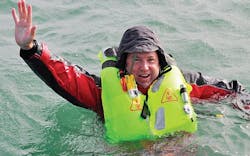Army evaluating prototypes from four companies for new mil-spec SATCOM personnel locator beacon
Officials of the Army Contracting Command at Aberdeen Proving Ground, Md., have asked the four companies each to develop four prototype militarized personal locator beacons that could be integrated into the Army's Personnel Recovery Support System (PRSS).
The companies that won PRSS contracts are the Boeing Co. Defense, Space & Security segment in St. Louis ($1.6 million); STS International Inc. in Berkeley Springs, W.Va. ($1.1 million); McMurdo Inc. in Lanham, Md. ($649,500); and BriarTek Inc. in Alexandria, Va. ($516,500).
The Army Contracting Command awarded the contracts last April on behalf of the Army Air Warrior Product Manager Office at Redstone Arsenal in Huntsville, Ala.
Related: Air Force awards $3.2 million contract to Boeing to build 512 CSEL pilot emergency radios
These contracts are part of the Army's PRSS Increment 1b program, which consists of a new mil-spec personal locator beacon designated the Personnel Recover Device (PRD). The four companies are submitting their prototype devices for evaluation, and the Army will select one company for full production.
The PRD will transmit open and secure waveforms, and provide an operation transport layer of SATCOM receivers integrated into a military search, rescue, and personnel recovery network architecture.
The companies are developing handheld devices that act as alert-and-notification systems that a soldier has become isolated, missing, detained, or captured.
Related: Navy looks to BriarTek to provide man-overboard warning systems for surface ship fleet
The PRD will increase the soldiers' chances of recovery through secure enhanced capabilities, improved accuracy and latency, decreased size, weight, and power requirements, as compared to devices involved in the PRSS Increment 1a project.
Each prototype PRD will have user changeable configuration parameters. The prototypes must be able to transmit non-secure international distress signals on the COSPAS-SARSAT frequency of 406 MHz, as well as secure signals for covert search and rescue. Tests will involve frequency stability, waveform compliance, data encoding, spurious emissions, and output power.
For more information contact Boeing Defense, Space & Security online at www.boeing.com/defense, STS International at www.stsint.com, McMurdo Inc. at www.mcmurdogroup.com, or BriarTek at www.briartek.com.
Learn more: search the Aerospace & Defense Buyer's Guide for companies, new products, press releases, and videos
